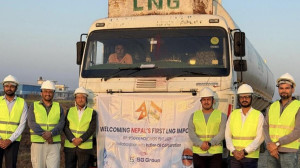Money
Government clears way for Amlekhgunj-Motihari project
The government has approved the environmental impact assessment (EIA) report for the Amlekhgunj-Motihari petroleum pipeline project, raising expectations that construction of the long-awaited infrastructure will start soon.
The government has approved the environmental impact assessment (EIA) report for the Amlekhgunj-Motihari petroleum pipeline project, raising expectations that construction of the long-awaited infrastructure will start soon.
According to Nepal Oil Corporation (NOC), the Ministry of Forests and Environment gave its okay to the EIA report last week. “Following the approval, we have been freed from restrictions like cutting down the trees along the alignment of the pipeline which had held up the construction work for a long time,” said NOC Director and Pipeline Project Chief Bhanu Bhakta Khanal.
In August 2015, Nepal and India signed a memorandum of understanding for the construction of the oil pipeline with the expectation of completing the project in 30 months. However, work on the pipeline started only last March with the target of having the pipeline in operation by June 2019. NOC spent more than a year attempting to get the EIA report okayed. During a bilateral meeting held September in Kathmandu, the Indian side had expressed concern over the slow progress in the EIA process. As per the state-owned oil monopoly, a major portion of the pipeline’s alignment lies along the Birgunj-Pathlaiya commercial highway that is undergoing expansion into a six-lane road. The project has completed laying 19 km of the pipeline out of the 36.2-km section that lies on Nepali territory. According to Khanal, NOC will need to cut down around 6,000 trees in Parsa National Park to lay the pipeline. The project has been allowed to lay 9 km of the pipeline inside the conservation area. “The pipeline does not pass through private property so there were no hassles on that front. The EIA process snagged on issues related to the national park,” Khanal said.
Most of the construction work has been completed in the Pathlaiya-Simara-Jitpur, Parwanipur, Birgunj bypass and Nepal-India border areas. Khanal said they had recently carried out horizontal directional drilling under the Birgunj customs area. “We constructed a 280-metre tunnel at a depth of 6 metres under the customs office to lay the pipeline,” Khanal said.
The project expects to dig a 1.6-km tunnel in Jitpur and a 2-km tunnel in Parwanipur. Khanal said they had originally planned to dig 2 km of tunnel, but they would need to dig 6 km of tunnel.
The oil pipeline is expected to ensure regular fuel supplies from India which are often disrupted by recurring road blocks and strikes. The estimated cost of the project is Rs4.4 billion. India will spend Rs3.2 billion while Nepal will contribute the rest, according to the bilateral agreement.




 7.12°C Kathmandu
7.12°C Kathmandu












